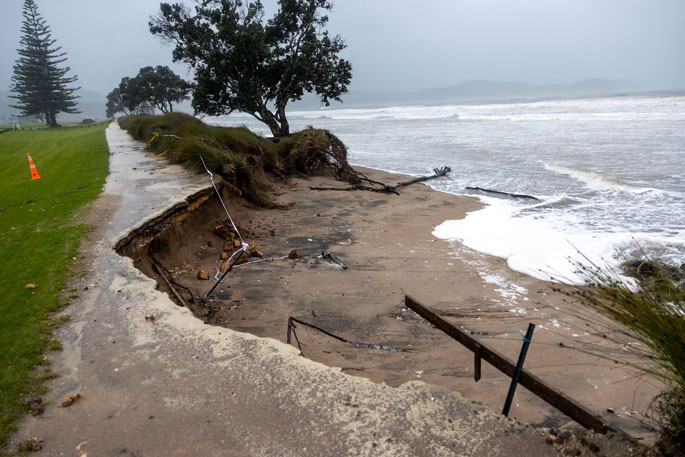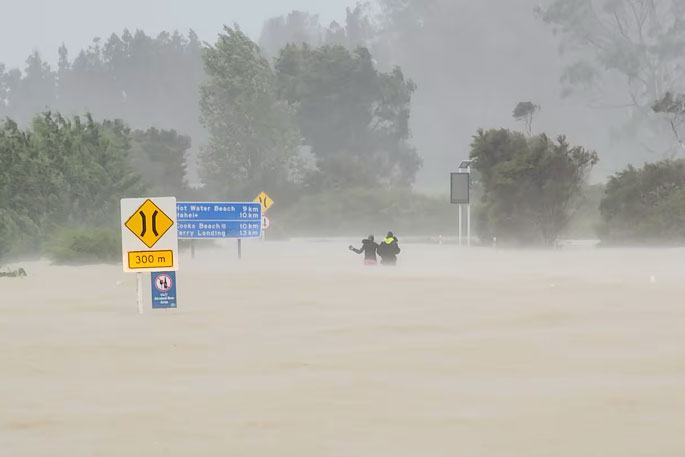Recovery work in the Coromandel following the 2023 cyclones is to be scaled back.
The announcement comes as Thames-Coromandel District Council emergency management unit published updated figures on transport network costs post Hale and Gabrielle cyclones.
It was confirmed recovery work would be scaled back by November, concluding a 20-month, multi-platform work programme involving every one of the council’s departments.
To date, the cost of the cyclone repairs, building resilience capability and social recovery investment had exceeded $170 million, council emergency management district manager Garry Towler said in the report.
The focus for staff in 2024 had remained on cyclone recovery.
Since early 2023, it was estimated NZTA Waka Kotahi had spent or committed $150m across the Coromandel state highway network.
While that sum was welcomed, it did not “do the job needing to be done” on the peninsula.
Local road recovery costs to date were $17.75m, with $8.5m of scheduled work still to be completed.
“Council will need to maintain advocacy to ensure that the peninsula’s state highways and local roads are made more resilient, through increased investment, over the next decade.”
As of last month, the council was managing 31 placarded properties, 24 yellow, and seven red.
Towler said council staff met regularly to discuss the situation with each placarded property, and where possible, provided assistance and advice in order to progress repairs and outstanding issues to a conclusion.
EQC Toka Tū Ake, (Earthquake Commission), legal, financial shortfalls, neighbour disputes, and third-party landowners were the main issues preventing closures.
 Flooding in Tairua in February 2023. Video still / Matthew Davidson.
Flooding in Tairua in February 2023. Video still / Matthew Davidson.
The council used placards to identify immediate safety risks at a property, and to tell people whether their home was safe to enter or stay in.
A yellow placard meant there was moderate damage or risk. A red placard meant there was a high risk to the property.
The Coromandel Community Resilience Project was in its final phase after 18 months.
All 36 communities around the Coromandel now had access to resilience kits and resources to support an initial community-led response in the event of a severe event.
Four containers, located in Thames, Coromandel, Whitianga and Whangamatā, stocked with Civil Defence centre cache resources, would be in place by November, signalling the completion of the project.
The project had been significant in a number of way. Grants and donations of $819,910 had enabled and enhanced community and council collaboration which, through existing community response groups, saw the project get under way quickly, within a month of the cyclones.
“Having the funding to purchase quality equipment and resources for each community, based on their specific needs, created genuine ‘ownership and engagement’.
“The value-added aspect of the project has changed, and greatly enhanced how council will manage emergency responses in the future,” Towler said in the report.
 The Whitianga foreshore on February 13, 2023, as Cyclone Gabrielle hit the Coromandel. Photo / Mike Scott.
The Whitianga foreshore on February 13, 2023, as Cyclone Gabrielle hit the Coromandel. Photo / Mike Scott.
There was better and more robust communication links with each community, the knowledge that communities had resources to support themselves for a short period, immediately after an event, and the additional training that had gone alongside the project would allow the emergency operating centre to better focus and target response and support.
One example was the speed and quality of intelligence and information that would come into the emergency operating centre, with less reliance on the “fickleness” of social media.
Relationships with iwi and marae communities were strengthened and enhanced by the project, with six marae receiving the first roll out of resilience kits together with training and ongoing support plans.
The significance of the project had also seen partners, such as PowerCo, invest heavily in three strategic locations around the Coromandel with large generators to power up local Civil Defence centres in the event of power outages.
 People wade through waist-high water after abandoning their car on the road to Hahei. Video still / Matthew Davidson.
People wade through waist-high water after abandoning their car on the road to Hahei. Video still / Matthew Davidson.
An external review of council’s emergency response to the February 2023 severe weather events identified and highlighted the need for better quality training and certification of council staff.
All staff employed by council were required to undergo a minimum of a half day Integrated Training Framework (ITF) Foundation training, with an opportunity for those interested to progress onto the two-day ITF Intermediate course, followed by more specialist function role training.
Over the past 12 months, the council’s community partnerships team had been focused on coordinating the implementation of social recovery actions outlined in the recovery plan with $1,565,336 spent in external grants and funding for social recovery efforts and bolstering community resilience.
The “Alert Coromandel” (Tsunami) project was completed in June with the installation of warning and information signage at all main beach access ways around the Coromandel.
All communities within the Coromandel had or were in the process of completing community response plans.
Summer planning 2024/2025 commenced this month with a risk management project involving all council departments, main contractors, and emergency services partners that had a customer facing connection over the summer period.
Solid waste, water services, roading, parks, wharfs, regulatory, events, communications, together with external emergency partners, Department of Conservation, Waikato Regional Council Surf Life Saving and NZ Health were all part of the planning and risk mitigation project.



0 comments
Leave a Comment
You must be logged in to make a comment.